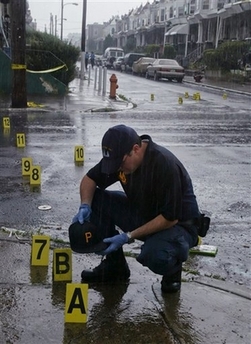FBI statistics Monday confirmed what big cities like Philadelphia, Houston,
Cleveland and Las Vegas have seen on the streets: Violent crime in the US is on
the rise, posting its biggest one-year increase since 1991.

A member of the crime
scene unit looks over evidence following a shooting in the Logan section
of Philadelphia that left one young man dead and another critically
wounded, in a Wednesday, June 7, 2006 file photo. Murders, robberies and
aggravated assaults in the United States increased last year, spurring an
overall rise in violent crime for the first time since 2001, according to
FBI data. Philadelphia murders increased from 330 to 377 in Philadelphia
last year, a 14 percent increase, according to FBI data.
[AP] |
In Philadelphia, homicides jumped from 330
in 2004 to 377 in 2005, a 14 percent increase, according to the FBI. Murders
climbed from 272 to 334 in Houston, a 23 percent rise, and from 131 to 144 in
Las Vegas, a 10 percent increase.
Jeffrey Sedgwick, director of the US Justice Department's Bureau of Justice
Statistics, cautioned that it is not yet clear whether the FBI numbers reflect a
real increase, or the ordinary year-to-year variations that statisticians call
"static noise."
Sedgwick said it is possible that crime rates in the US are approaching a
floor below which it may be difficult or even impossible to go. "I'm not sure
it's reasonable to expect you can always drive the crime rate down," he said.
Some criminal justice experts said the statistics reflect the nation's
complacency in fighting crime. Crime dropped dramatically during 1990s, and some
cities have since abandoned effective programs that emphasized prevention, the
putting of more cops on the street, and controls on the spread of guns.
"We see that budgets for policing are being slashed and the federal
government has gotten out of that business," said James Alan Fox, a criminal
justice professor at Northeastern University in Boston. Still, Fox said, "We're
still far better off than we were during the double-digit crime inflation we saw
in the 1970s."
In Philadelphia, which has had more than 160 murders this year, the police
department has responded by creating a special unit charged with roaming the
streets in the dangerous hours between 10 p.m. and 3 a.m. The program, which is
expected to start soon, will shift 46 officers from other assignments.
Philadelphia police Capt. Benjamin Naish said more people appear to be
settling disputes with guns.
"I think that everybody continues to be frustrated within the government,
within the department," he said. Philadelphia police have stressed that the
number of killings is still below the averages in the mid-1990s and far below
the 525 homicides in 1990.
The overall national increase in violent crime was modest, 2.5 percent, which
equates to more than 1.4 million crimes. Nevertheless, that was the largest
percentage increase since 1991.
Nationally, murders rose 4.8 percent, meaning there were more than 16,900
victims in 2005. That would be the most since 1998 and the largest percentage
increase in 15 years.
Some big cities felt the brunt.
Murders rose from 59 to 104 in Birmingham, Ala., up 76 percent; from 59 to 85
in Charlotte-Mecklenburg County, N.C., a 44 percent spike; from 89 to 126 in
Kansas City, Mo., a 42 percent rise; from 87 to 122 in Milwaukee, a 40 percent
jump; and from 79 to 109 in Cleveland, up 38 percent.
"The killings are going in spurts," said Judy Martin, a victims' advocate in
Cleveland whose son was shot to death in a 1994 carjacking. "A number of the
murders this year seem to come from a number of young men jumping on someone and
killing them. We are going downhill."
Detroit, Los Angeles and New York were among several big cities that saw
murder numbers drop.
Theories about New York's decline vary. Some experts point to favorable
shifts in demographics and the economy, as well as the crash of a once-thriving
crack market that fueled violence in the 1980s.
Officials in the 36,000-officer department, the nation's largest, credit
their crime-fighting approach. They cite a tactic refined over the past decade
in which commanders use computers to track crime patterns ¡ª particularly those
involving guns and drugs ¡ª and deploy patrols where and when criminals are most
active.
Police in Houston attributed some of their spike in violent crime to New
Orleans gang members who evacuated there along with thousands of other victims
of Hurricane Katrina last fall.
The FBI figures were released on the same day authorities announced the
arrest in Louisiana of a Katrina evacuee considered one of the Houston area's
most-wanted killers. Authorities said he robbed two other evacuees of their FEMA
money and shot them, killing one.